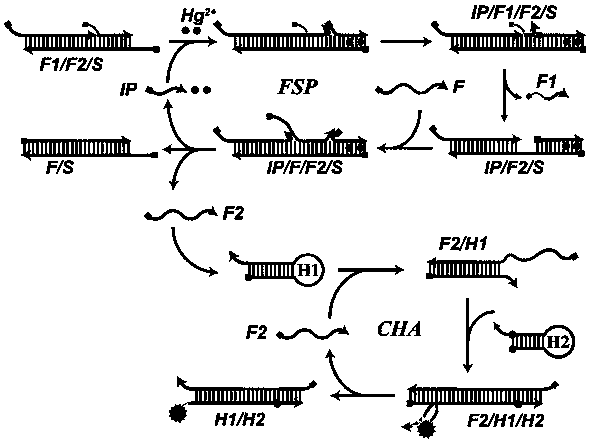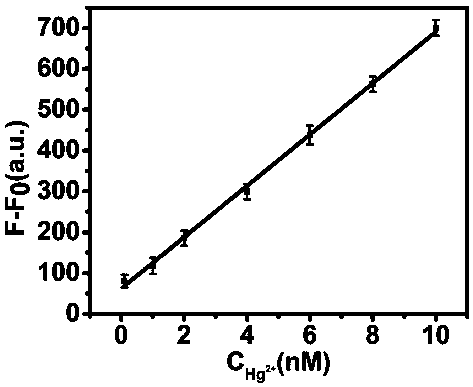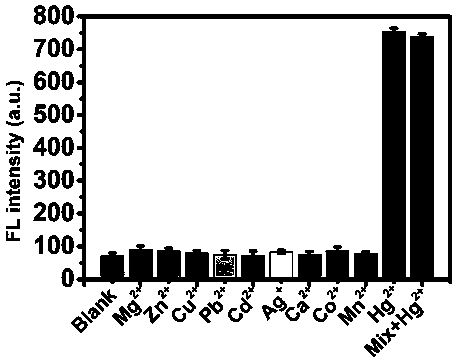Dual-signal-amplification fluorescence sensor for detecting mercury ions and preparation method thereof
A fluorescent sensor and dual-signal technology, applied in the field of biosensors, can solve the problems of limiting the scope of use of traditional methods and real-time operability, and achieve the effects of fast response, mild reaction conditions, and improved sensitivity
- Summary
- Abstract
- Description
- Claims
- Application Information
AI Technical Summary
Problems solved by technology
Method used
Image
Examples
Embodiment 1
[0045] Template DNA probe, mercury ion recognition probe DNA probe, fuel probe, hairpin probe and fluorescent dye BHQ-2 and FAM modified hairpin probe sequence design are shown in Table 1;
[0046] Table 1. Complete sequence of sensors.
[0047]
Embodiment 2
[0048] Embodiment 2 Preparation of each component
[0049] (1) Synthesis of component a
[0050] Use 1×HEPES buffer to prepare probe S, F1 and F2 solutions with a concentration of 100 μM, take a 200 μL centrifuge tube, add 1 μL probe S (100 μM), 1 μL F1 (100 μM) and 1 μL F2 (100 μM), Supplement with 97 μL of 1×HEPES buffer (10 mM HEPES, 20 mM magnesium acetate, 150 mM sodium acetate, pH 7.4). Keep the centrifuge tube in a constant temperature metal bath at 30°C for 3 hours to fully hybridize and form the template DNA hybrid S / F1 / F2.
[0051] (2) Use 1×HEPES buffer to prepare a solution with a probe IP concentration of 1 μM, that is, component b.
[0052] (3) Use 1×HEPES buffer to prepare a solution with a concentration of F of 1 μM, that is, component c.
Embodiment 3
[0053] Embodiment 3 Annealing treatment of the hairpin probe
[0054] (1) Annealing of hairpin probe H1
[0055] Use 1×HEPES buffer to prepare probe H1 solution with a concentration of 2 μM, take a 200 μL centrifuge tube, add 1 μL H1 (100 μM) and 49 μL 1×HEPES buffer (10 mM HEPES, 20 mM magnesium acetate, 150 mM acetic acid sodium, pH 7.4). Keep the centrifuge tube in a constant temperature metal bath at 95°C for 5 minutes, and then quickly place it in ice water for 30 minutes to form a stable secondary structure.
[0056] (2) Annealing of fluorescent dye BHQ-2 and FAM-modified hairpin probe H2
[0057] Use 1×HEPES buffer to prepare a probe H2 solution with a concentration of 2 μM, take a 200 μL centrifuge tube, add 1 μL H2 (100 μM) and 49 μL 1×HEPES buffer (10 mM HEPES, 20 mM magnesium acetate, 150 mM acetic acid sodium, pH 7.4). Keep the centrifuge tube in a constant temperature metal bath at 95°C for 5 minutes, and then quickly place it in ice water for 30 minutes to fo...
PUM
| Property | Measurement | Unit |
|---|---|---|
| wavelength | aaaaa | aaaaa |
| emission peak | aaaaa | aaaaa |
Abstract
Description
Claims
Application Information
 Login to View More
Login to View More - R&D
- Intellectual Property
- Life Sciences
- Materials
- Tech Scout
- Unparalleled Data Quality
- Higher Quality Content
- 60% Fewer Hallucinations
Browse by: Latest US Patents, China's latest patents, Technical Efficacy Thesaurus, Application Domain, Technology Topic, Popular Technical Reports.
© 2025 PatSnap. All rights reserved.Legal|Privacy policy|Modern Slavery Act Transparency Statement|Sitemap|About US| Contact US: help@patsnap.com



